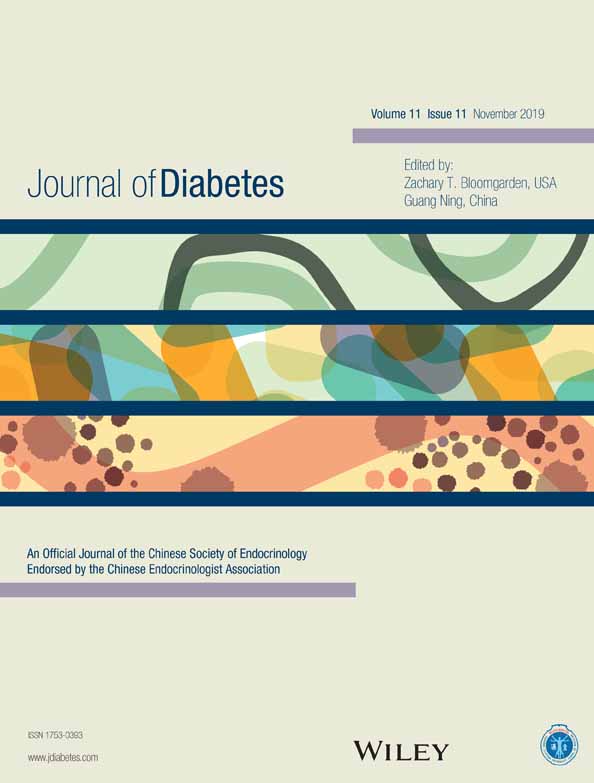Genetic predisposition to gestational glucose metabolism and gestational diabetes mellitus risk in a Chinese population
中国人群中妊娠期血糖代谢相关遗传易感性位点与妊娠糖尿病风险的关联研究
Funding information National Natural Science Foundation of China, Grant/Award Numbers: 81770866, 81702569, 81670773; Jiangsu Provincial Medical Innovation Team, Grant/Award Number: CXTDA2017001; Jiangsu Provincial Medical Youth Talent, Grant/Award Number: QNRC2016108; Jiangsu Province Natural Science Foundation, Grant/Award Numbers: BK20170151, BK20160141; Jiangsu Provincial Key Research and Development Program, Grant/Award Numbers: BE2016619, BE2018614, BE2018616; 333 High Level Talents Training Project of Jiangsu Province, Jiangsu Provincial Women and Children Health Research Project, Grant/Award Number: F201762; Jiangsu Province “Six Talent Peak” Personal Training Project, Grant/Award Numbers: 2016-WSW-086, 2015-WSW-043, YY-081; Nanjing Medical Science and Technique Development Foundation, Grant/Award Number: JQX18009; National Key Laboratory of Reproductive Medicine Foundation, Grant/Award Number: SKLRM-GC201805
Abstract
enBackground
Genome-wide association studies (GWAS) have identified several genetic variants affecting gestational glucose metabolism. However, information regarding their known associations with gestational diabetes mellitus (GDM) risk remains scarce.
Methods
This study examined the associations of 12 gestational glucose metabolism-related variants with GDM risk in a Chinese population (964 GDM cases, 1021 controls). Odds ratios (ORs) and 95% confidence intervals (CIs) were calculated by logistic regression analysis.
Results
Rs10830963 in melatonin receptor 1B (MTNR1B) was found to be associated with an increased risk of GDM, after adjusting for age, prepregnancy body mass index, parity, abnormal pregnancy history, and family history of diabetes (OR 1.20; 95% CI 1.05-1.36; P = 0.007). Compared with women with a family history of diabetes, there was a significant association of rs7936247 with GDM risk among pregnant women without a family history of diabetes (OR 1.20; 95% CI 1.04-1.38; P = 0.014; Pheterogeneity = 0.035). Further functional annotations showed that rs10830963 and rs7936247 fell in the functional elements of human pancreatic islets. Genotype-phenotype associations indicated that the variants may contribute to GDM risk by affecting the expression of nearby or distant genes.
Conclusions
The findings of this study suggest that rs10830963 and rs7936247 may be markers for susceptibility to GDM in a Chinese population. Additional studies are warranted to validate our findings and clarify the underlying mechanism.
摘要
zh目的
全基因组关联研究(genome-wide association studies, GWAS)发现了一些与妊娠期血糖代谢水平相关的遗传易感性位点,但这些位点与妊娠糖尿病(gestational diabetes mellitus, GDM)风险的关系仍然较少。
方法
本研究探讨在中国人群样本中(964例妊娠糖尿病, 1021例健康对照)分析了12个与妊娠期糖代谢相关的遗传易感位点与GDM风险的关系。通过logistic回归分析计算这些位点与GDM发病的优势比(odds ratios, ORs)以及95%可信区间(95% confidence intervals, 95% CIs)。
结果
褪黑素受体1B (MTNR1B)位点rs10830963在校正年龄、孕前体重指数、胎次、异常妊娠史、糖尿病家族史等因素后,与GDM风险显著相关 (OR=1.20; 95% CI: 1.05-1.36; P=0.007)。与有糖尿病家族史的女性相比,rs7936247在无糖尿病家族史孕妇的人群中与GDM风险显著相关(OR=1.20; 95% CI: 1.04 -1.38; P=0.014;P异质性=0.035)。进一步在功能注释发现rs10830963和rs7936247位于人类胰岛β细胞的功能元件上,基因型-表型分析显示这两个变异位点可能通过影响邻近或远端基因的表达而导致GDM风险。
结论
本研究发现rs10830963和rs7936247可能是中国人群GDM风险的遗传易感性标志物,后续需要功能学实验来验证我们的结果及阐明其潜在的生物学机制。




